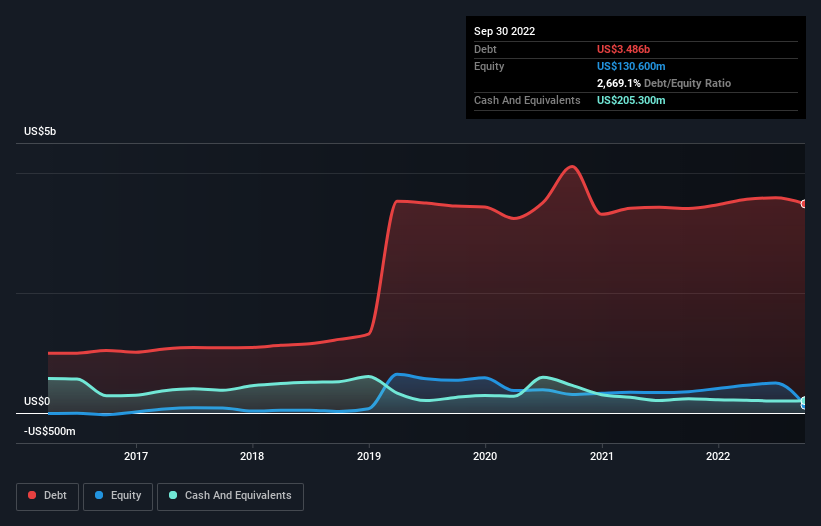- United States
- /
- Household Products
- /
- NYSE:ENR
Here's Why Energizer Holdings (NYSE:ENR) Is Weighed Down By Its Debt Load

Legendary fund manager Li Lu (who Charlie Munger backed) once said, 'The biggest investment risk is not the volatility of prices, but whether you will suffer a permanent loss of capital.' So it might be obvious that you need to consider debt, when you think about how risky any given stock is, because too much debt can sink a company. Importantly, Energizer Holdings, Inc. (NYSE:ENR) does carry debt. But the more important question is: how much risk is that debt creating?
When Is Debt Dangerous?
Generally speaking, debt only becomes a real problem when a company can't easily pay it off, either by raising capital or with its own cash flow. Ultimately, if the company can't fulfill its legal obligations to repay debt, shareholders could walk away with nothing. While that is not too common, we often do see indebted companies permanently diluting shareholders because lenders force them to raise capital at a distressed price. Having said that, the most common situation is where a company manages its debt reasonably well - and to its own advantage. When we think about a company's use of debt, we first look at cash and debt together.
Check out our latest analysis for Energizer Holdings
What Is Energizer Holdings's Debt?
The chart below, which you can click on for greater detail, shows that Energizer Holdings had US$3.49b in debt in September 2022; about the same as the year before. On the flip side, it has US$205.3m in cash leading to net debt of about US$3.28b.

A Look At Energizer Holdings' Liabilities
The latest balance sheet data shows that Energizer Holdings had liabilities of US$697.9m due within a year, and liabilities of US$3.74b falling due after that. On the other hand, it had cash of US$205.3m and US$479.3m worth of receivables due within a year. So it has liabilities totalling US$3.76b more than its cash and near-term receivables, combined.
Given this deficit is actually higher than the company's market capitalization of US$2.62b, we think shareholders really should watch Energizer Holdings's debt levels, like a parent watching their child ride a bike for the first time. Hypothetically, extremely heavy dilution would be required if the company were forced to pay down its liabilities by raising capital at the current share price.
In order to size up a company's debt relative to its earnings, we calculate its net debt divided by its earnings before interest, tax, depreciation, and amortization (EBITDA) and its earnings before interest and tax (EBIT) divided by its interest expense (its interest cover). The advantage of this approach is that we take into account both the absolute quantum of debt (with net debt to EBITDA) and the actual interest expenses associated with that debt (with its interest cover ratio).
Energizer Holdings has a rather high debt to EBITDA ratio of 5.9 which suggests a meaningful debt load. However, its interest coverage of 2.8 is reasonably strong, which is a good sign. Investors should also be troubled by the fact that Energizer Holdings saw its EBIT drop by 12% over the last twelve months. If things keep going like that, handling the debt will about as easy as bundling an angry house cat into its travel box. When analysing debt levels, the balance sheet is the obvious place to start. But ultimately the future profitability of the business will decide if Energizer Holdings can strengthen its balance sheet over time. So if you're focused on the future you can check out this free report showing analyst profit forecasts.
But our final consideration is also important, because a company cannot pay debt with paper profits; it needs cold hard cash. So we clearly need to look at whether that EBIT is leading to corresponding free cash flow. In the last three years, Energizer Holdings's free cash flow amounted to 24% of its EBIT, less than we'd expect. That weak cash conversion makes it more difficult to handle indebtedness.
Our View
On the face of it, Energizer Holdings's level of total liabilities left us tentative about the stock, and its net debt to EBITDA was no more enticing than the one empty restaurant on the busiest night of the year. And even its interest cover fails to inspire much confidence. Taking into account all the aforementioned factors, it looks like Energizer Holdings has too much debt. While some investors love that sort of risky play, it's certainly not our cup of tea. When analysing debt levels, the balance sheet is the obvious place to start. However, not all investment risk resides within the balance sheet - far from it. These risks can be hard to spot. Every company has them, and we've spotted 4 warning signs for Energizer Holdings (of which 3 are a bit unpleasant!) you should know about.
If you're interested in investing in businesses that can grow profits without the burden of debt, then check out this free list of growing businesses that have net cash on the balance sheet.
Valuation is complex, but we're here to simplify it.
Discover if Energizer Holdings might be undervalued or overvalued with our detailed analysis, featuring fair value estimates, potential risks, dividends, insider trades, and its financial condition.
Access Free AnalysisHave feedback on this article? Concerned about the content? Get in touch with us directly. Alternatively, email editorial-team (at) simplywallst.com.
This article by Simply Wall St is general in nature. We provide commentary based on historical data and analyst forecasts only using an unbiased methodology and our articles are not intended to be financial advice. It does not constitute a recommendation to buy or sell any stock, and does not take account of your objectives, or your financial situation. We aim to bring you long-term focused analysis driven by fundamental data. Note that our analysis may not factor in the latest price-sensitive company announcements or qualitative material. Simply Wall St has no position in any stocks mentioned.
About NYSE:ENR
Energizer Holdings
Manufactures, markets, and distributes household batteries, specialty batteries, and lighting products worldwide.
Average dividend payer slight.
Similar Companies
Market Insights
Community Narratives




